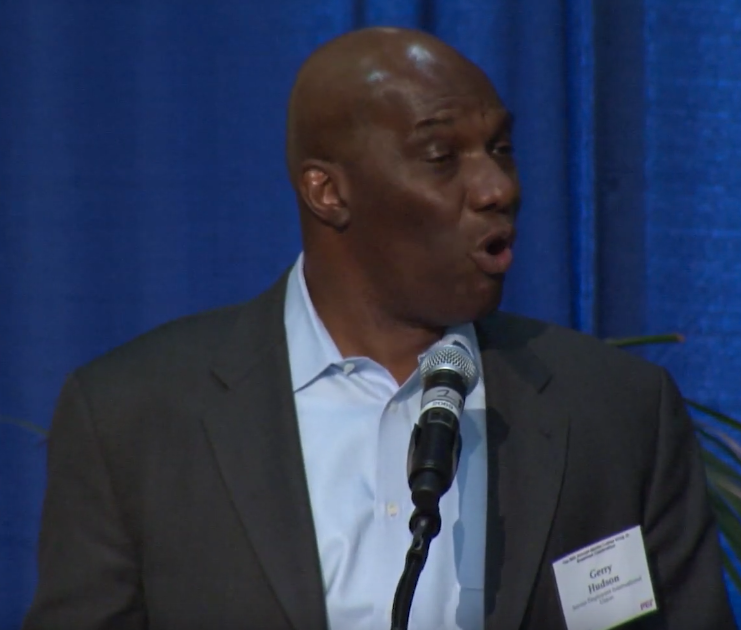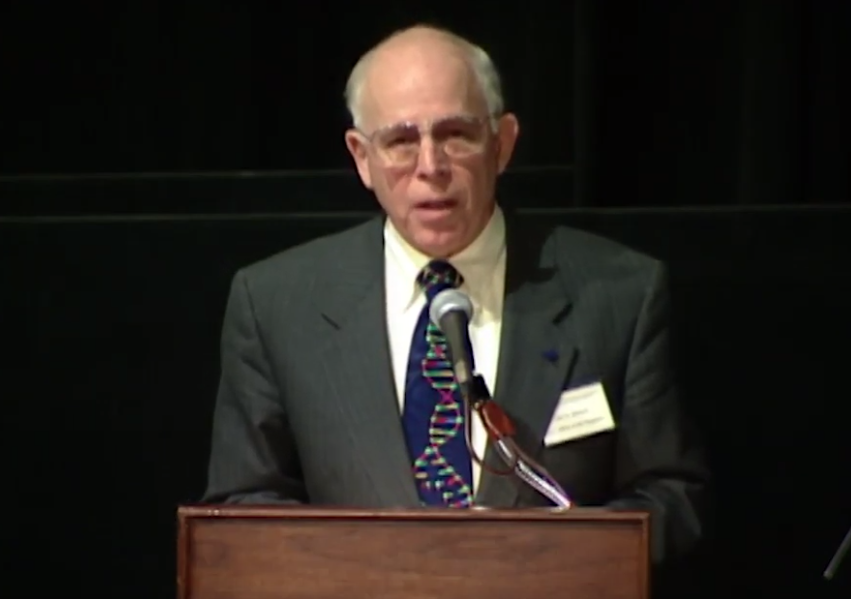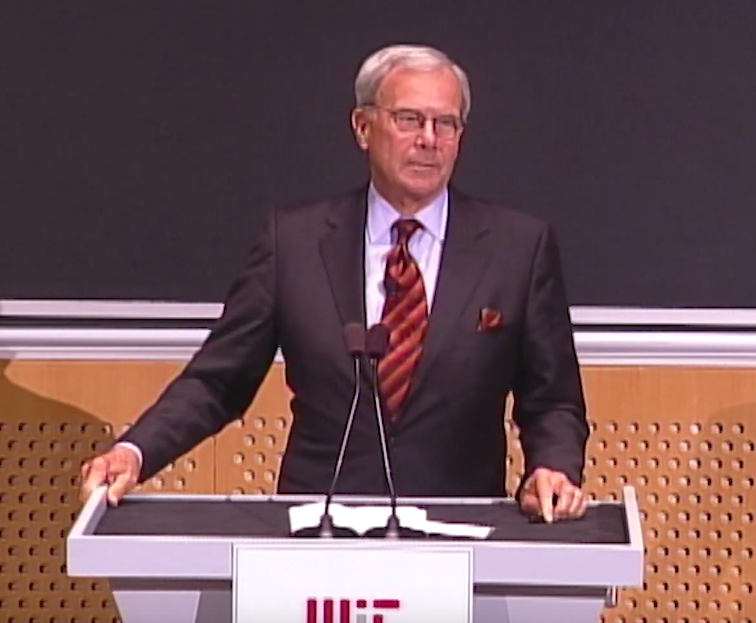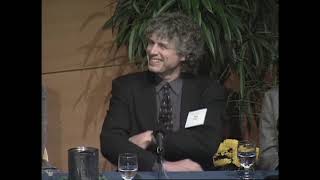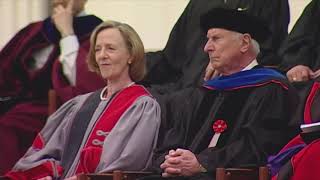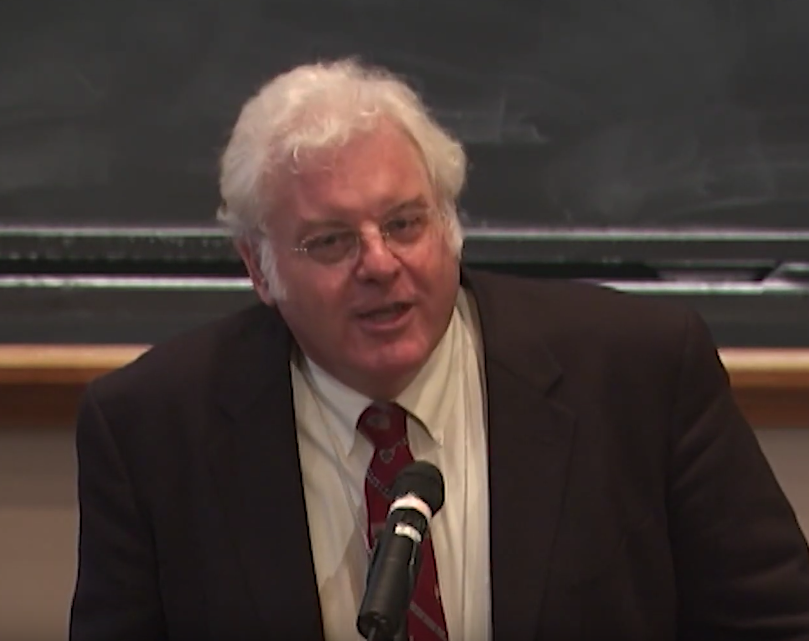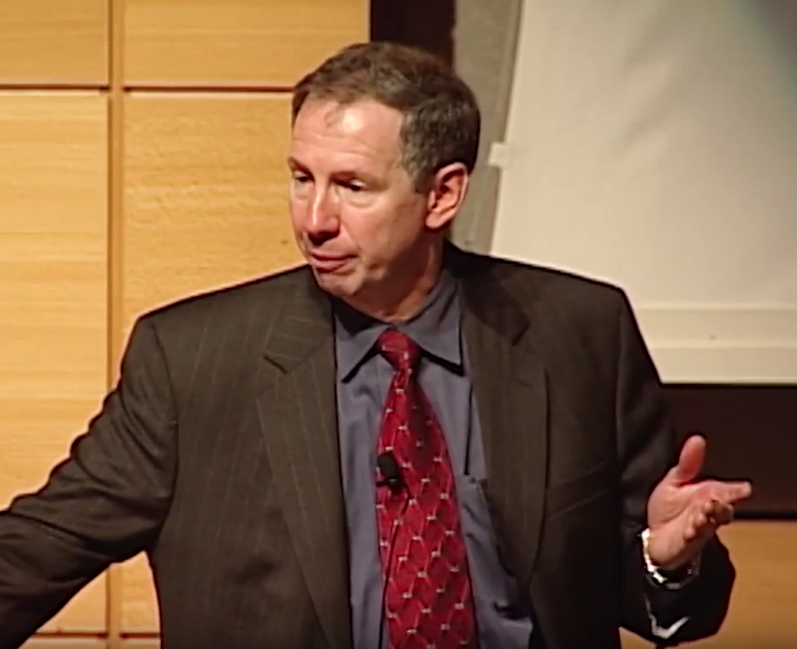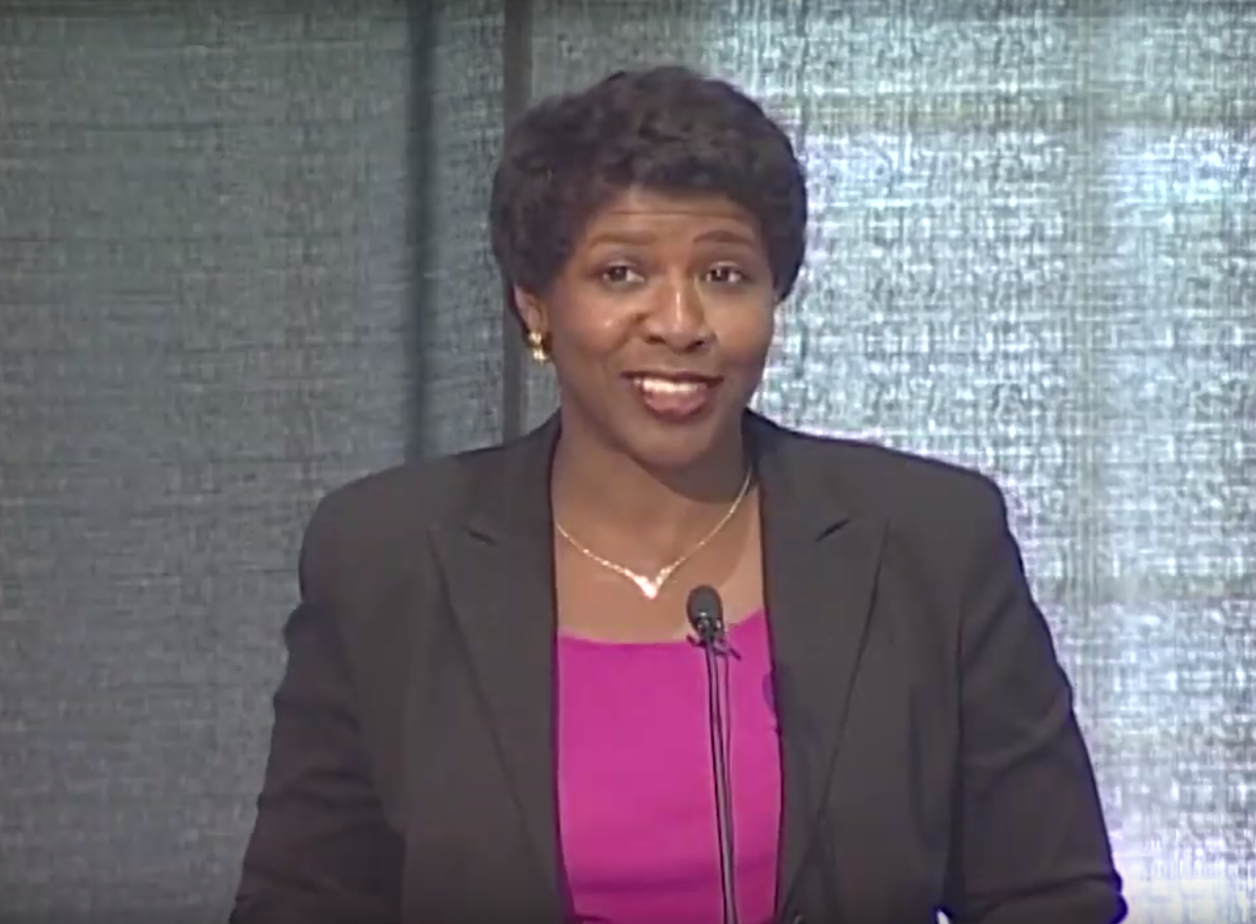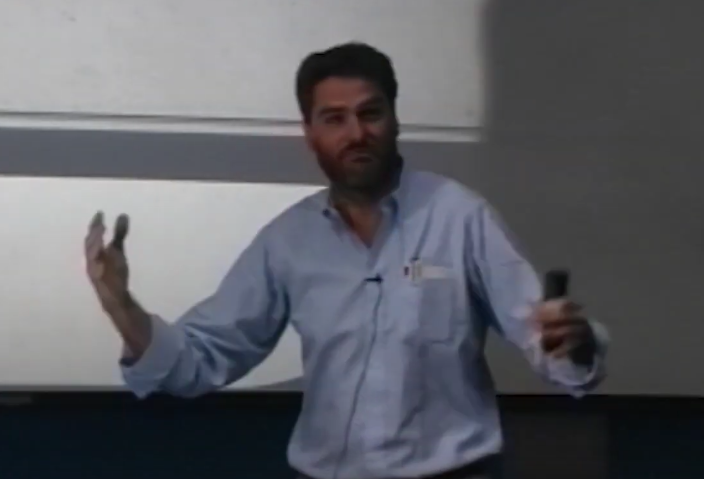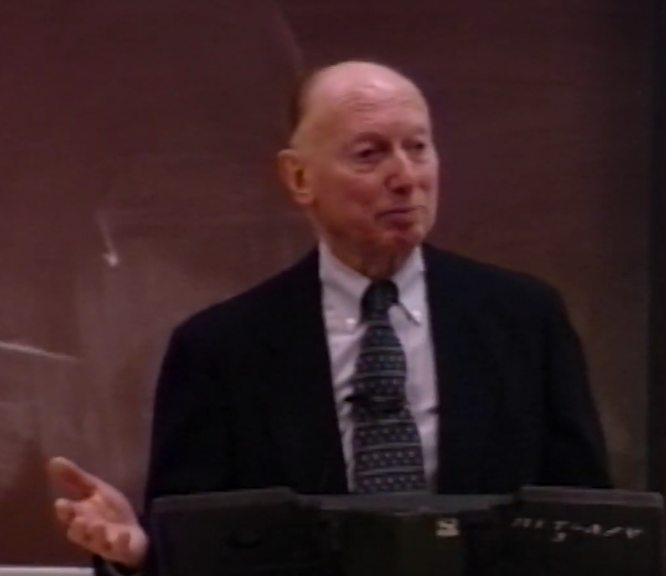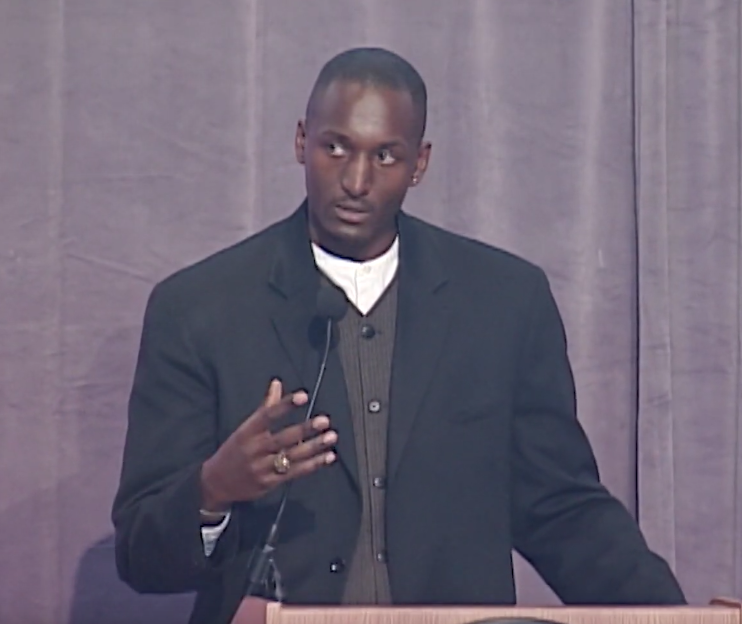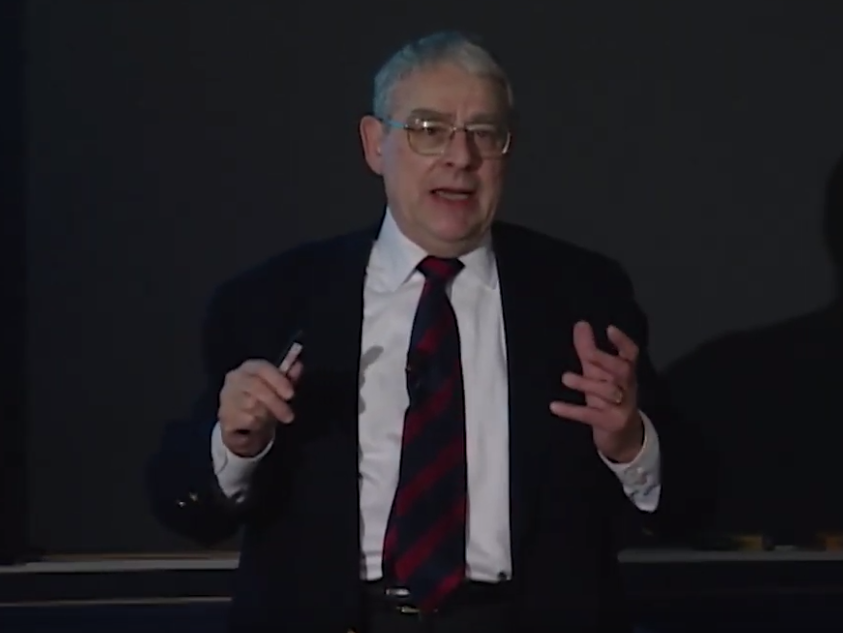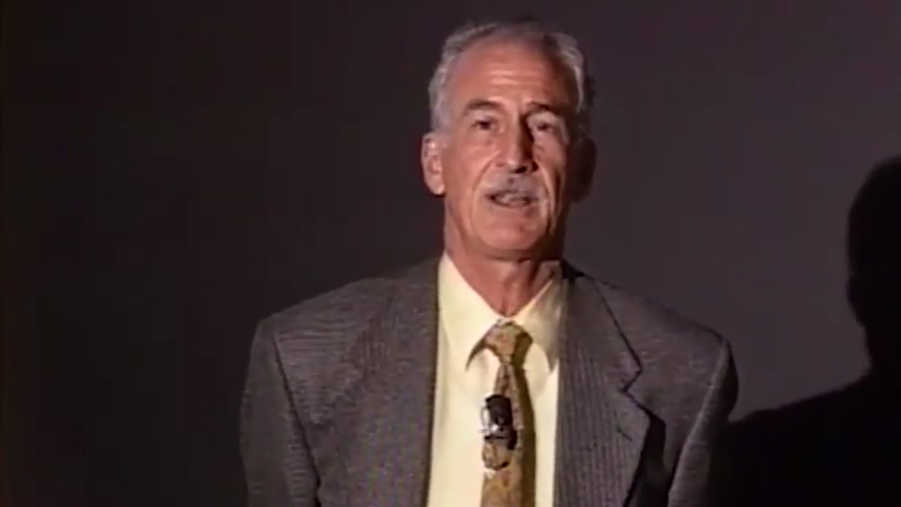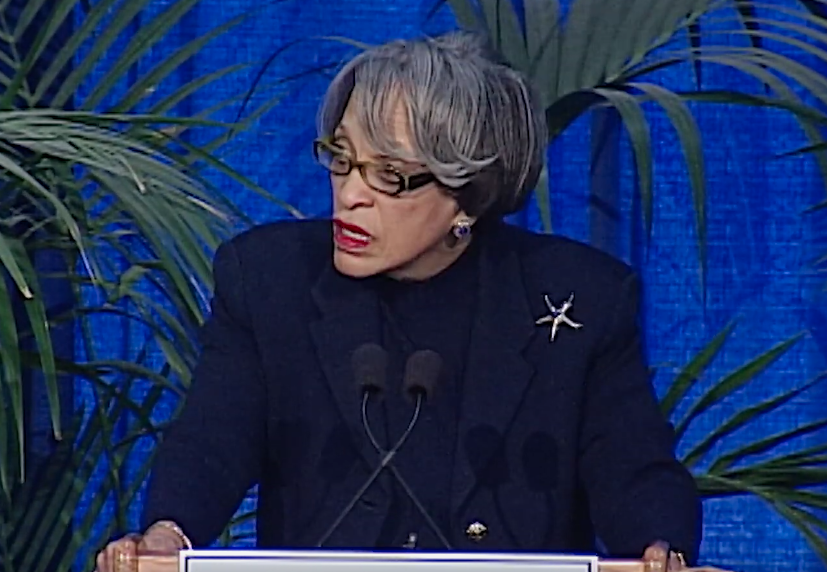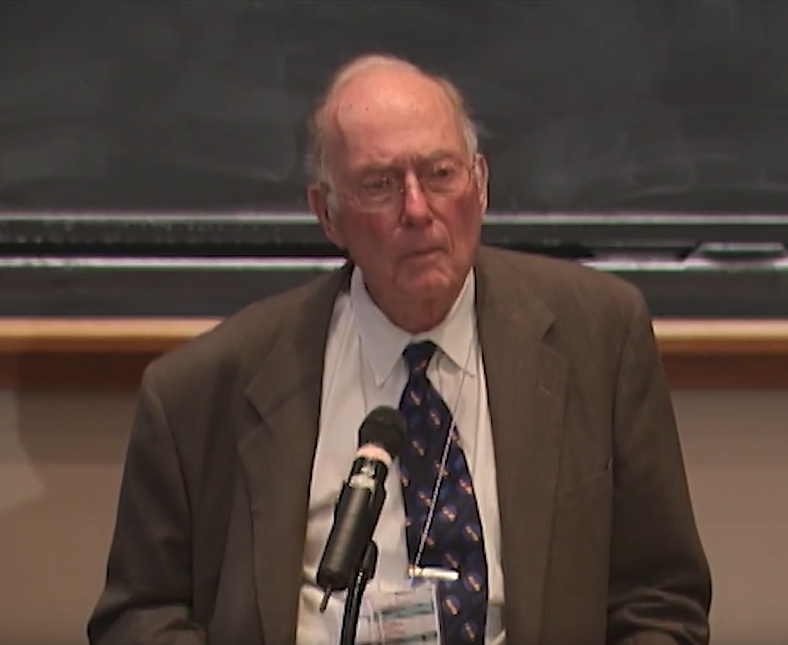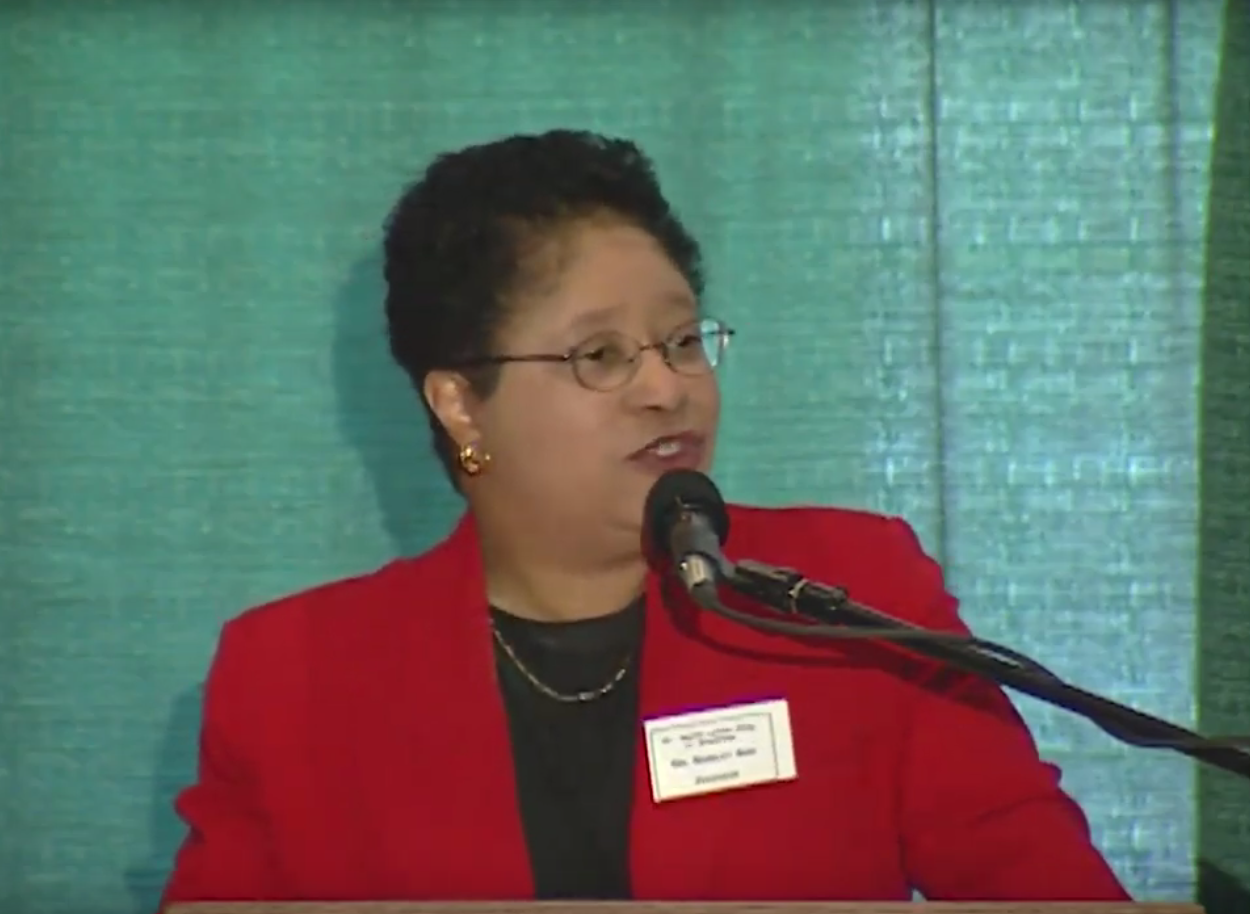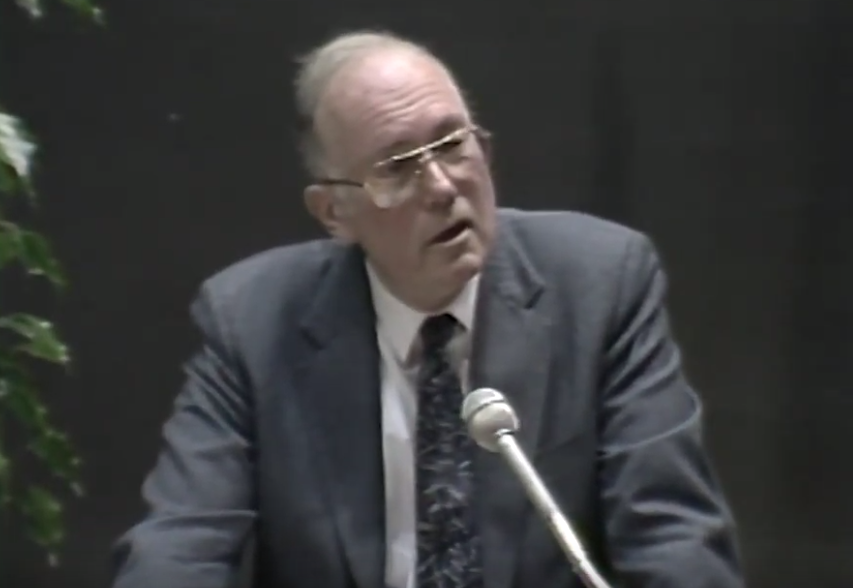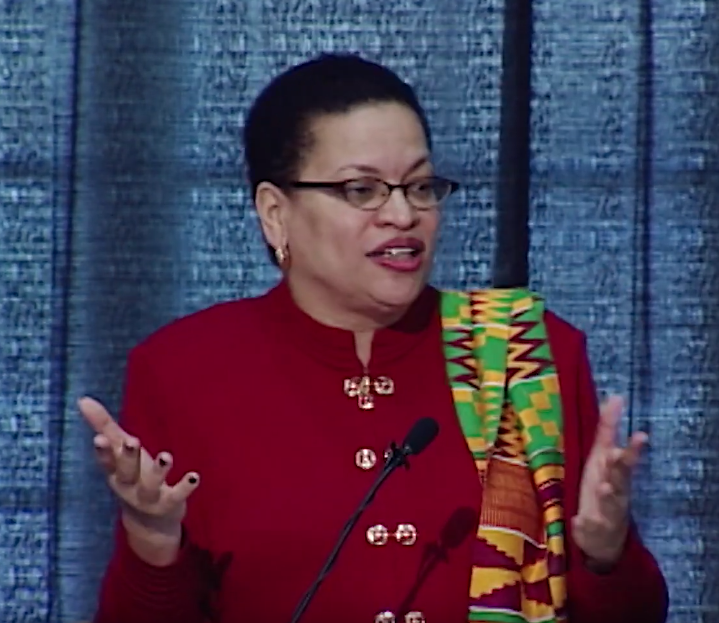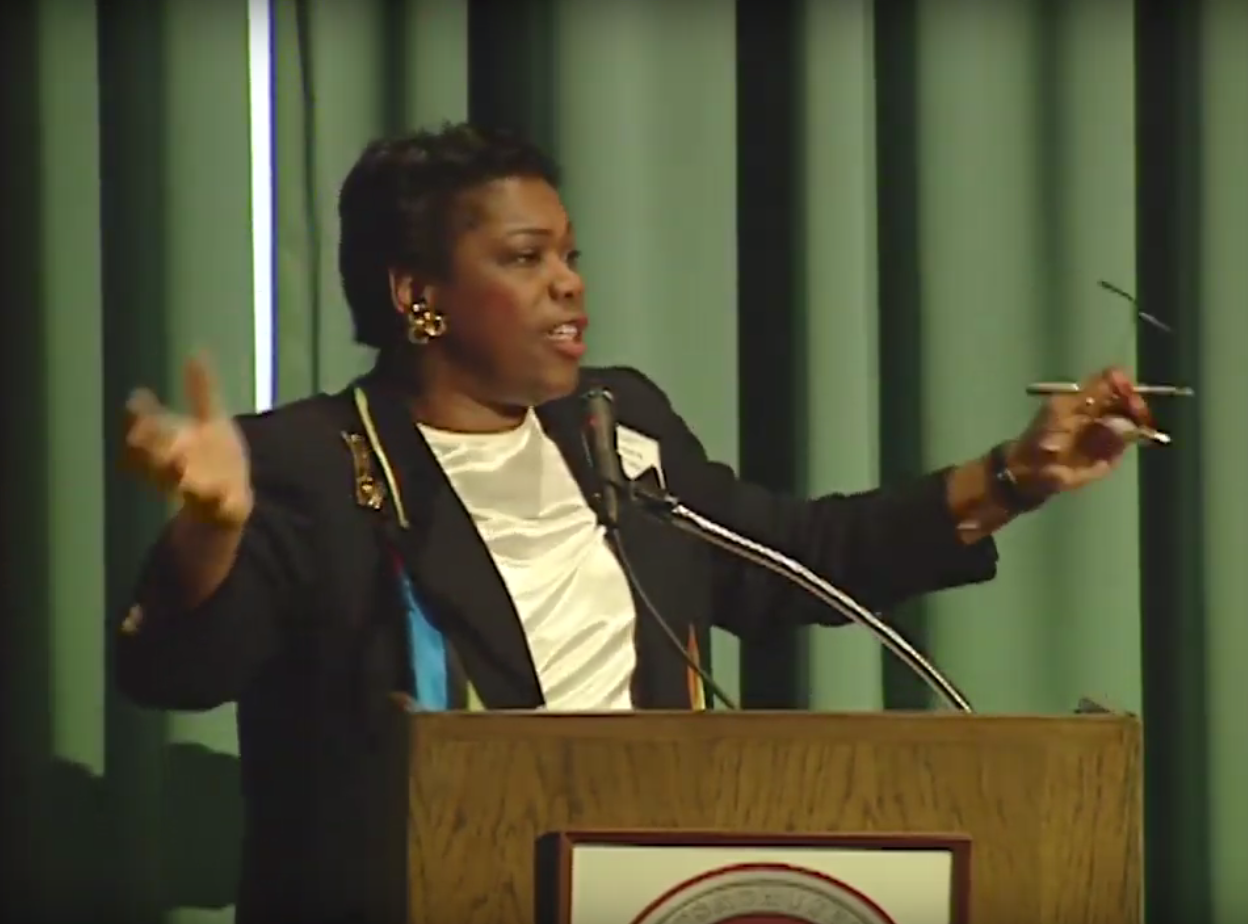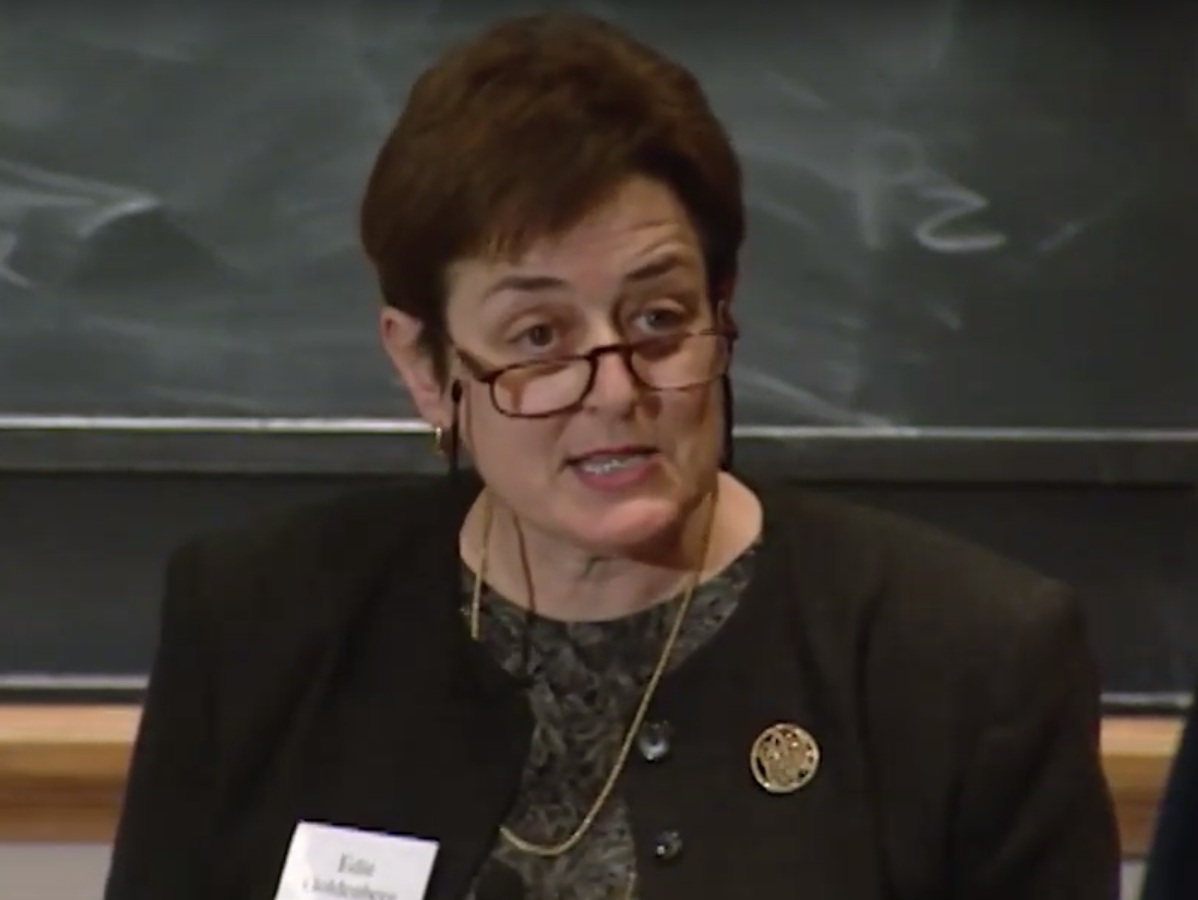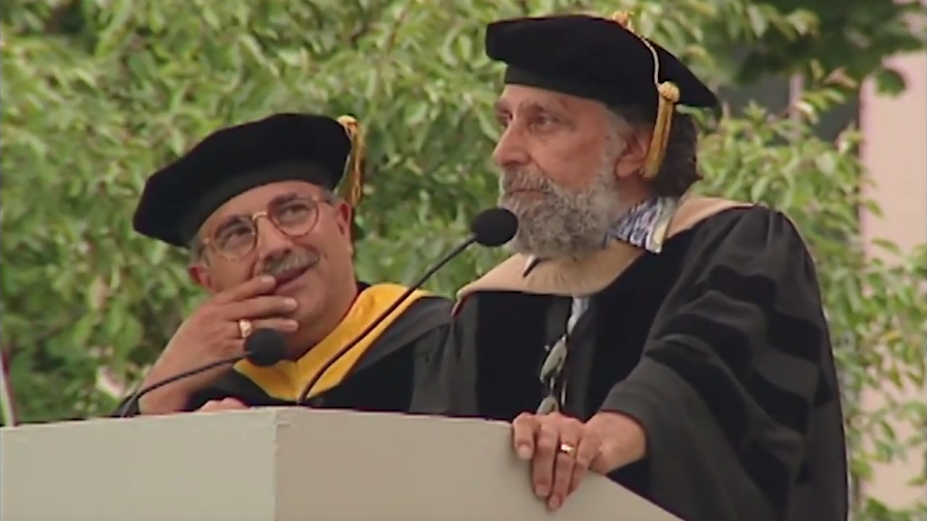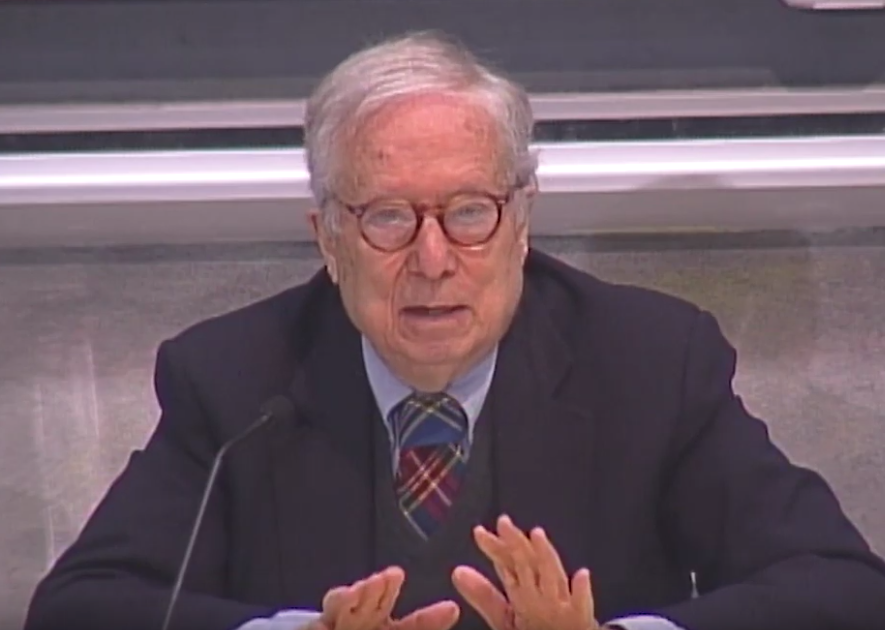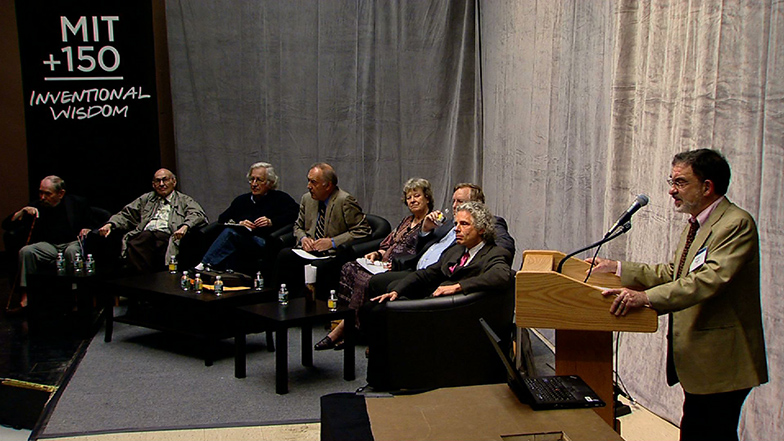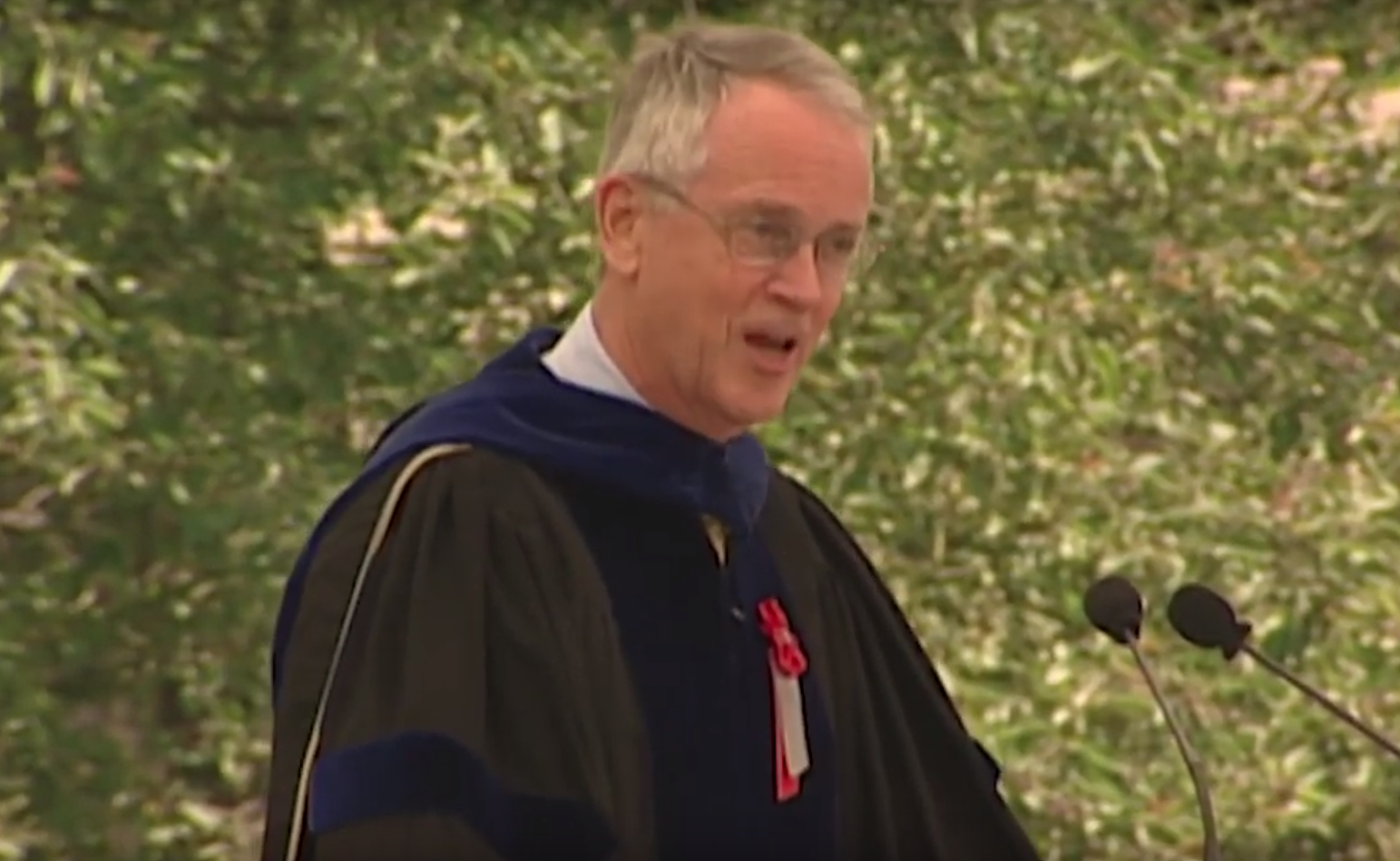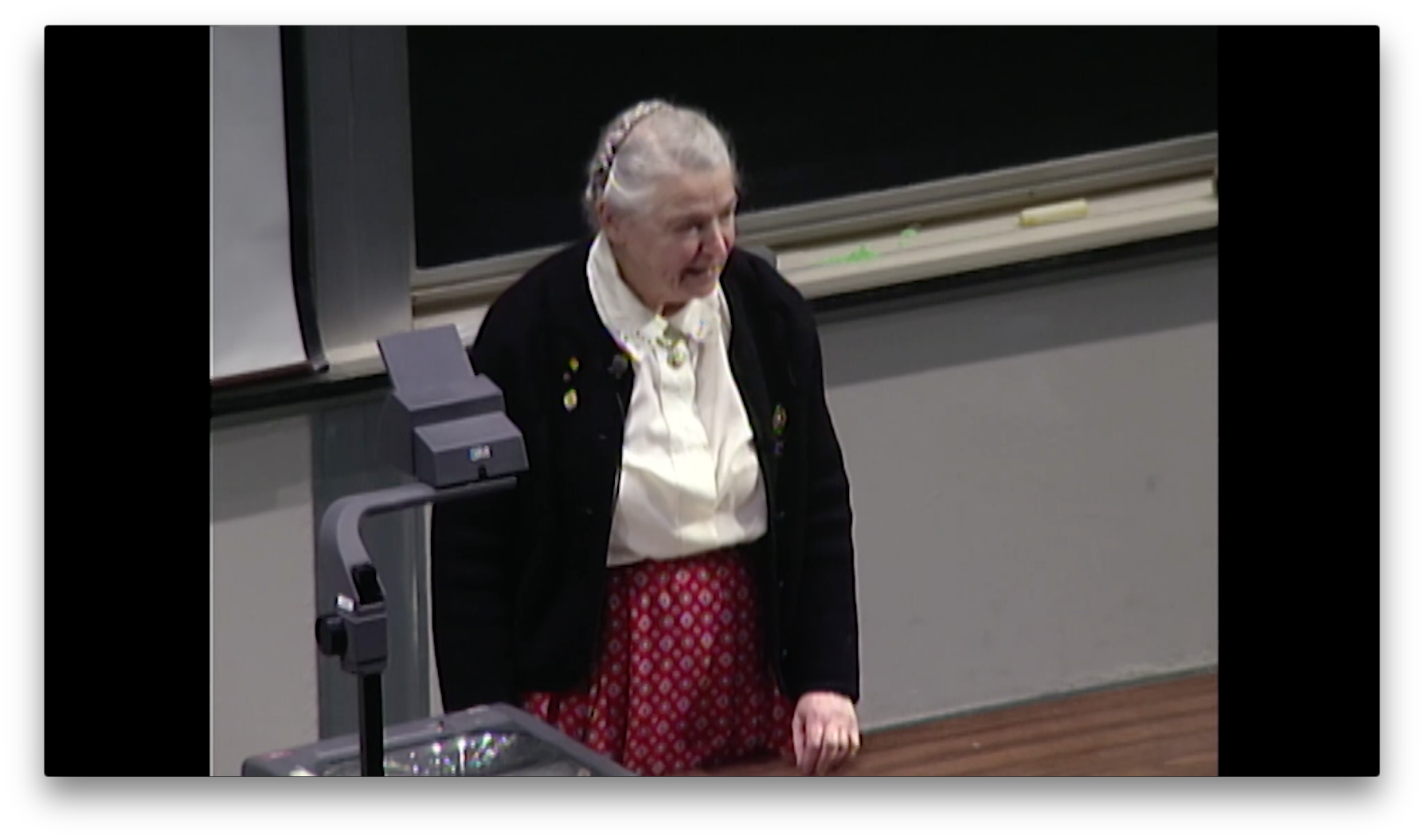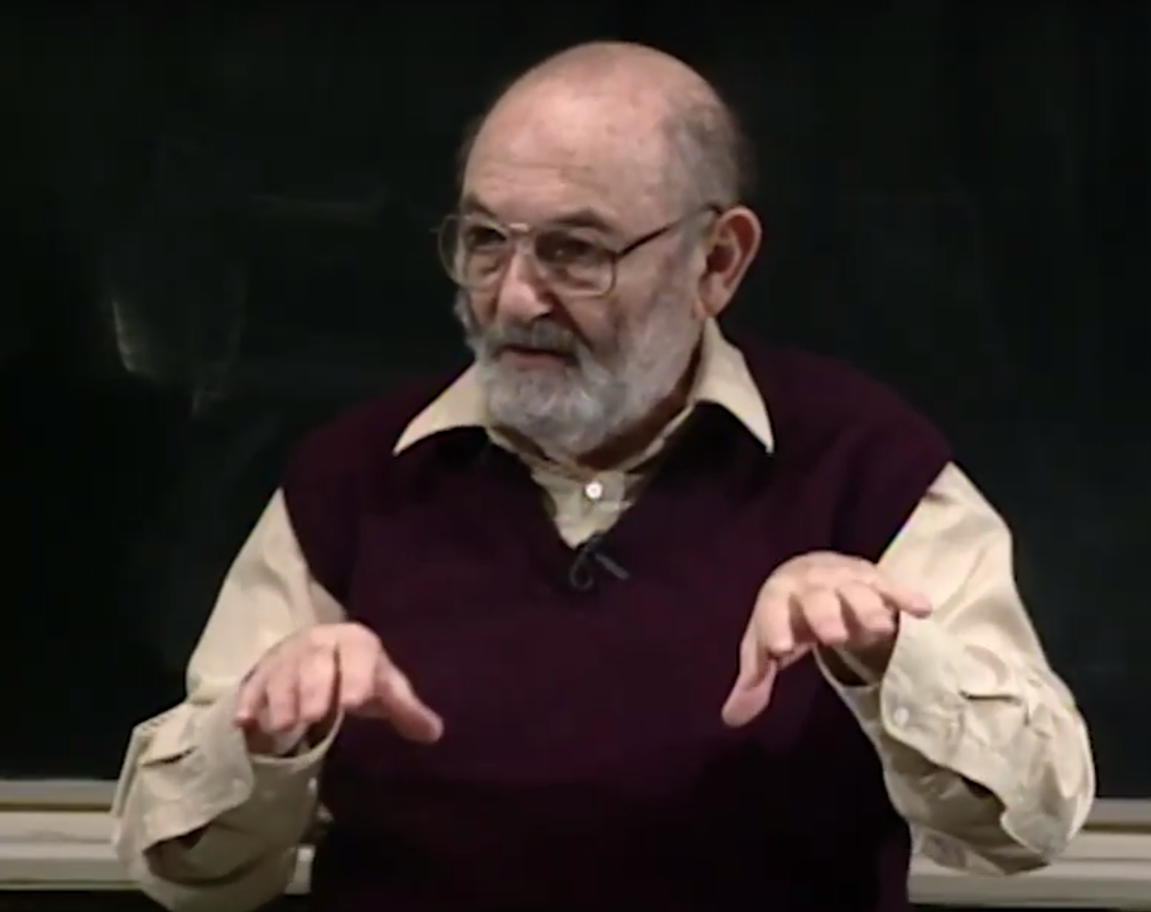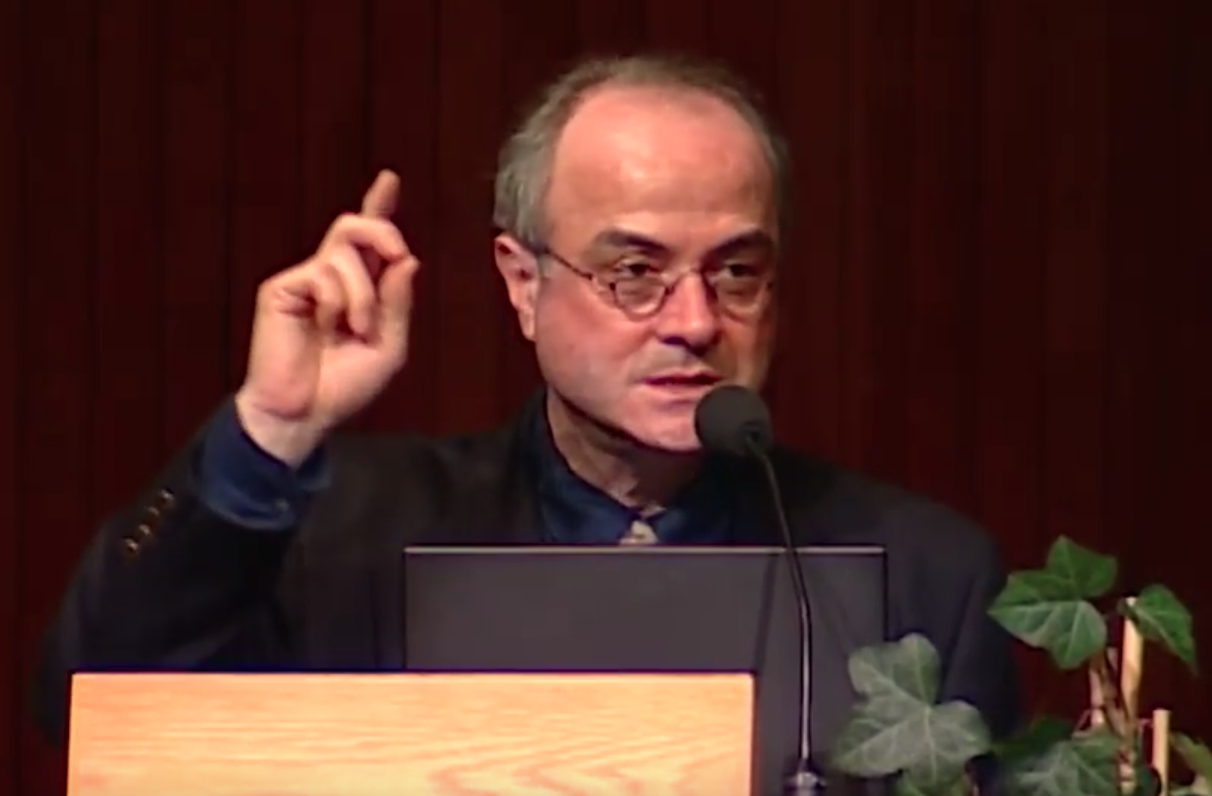Bobby Braun, “Investments in Our Future: Exploring Space Through Innovation and Technology” - MA Space Grant Consortium Public Lecture at MIT (4/20/2011)
[MUSIC PLAYING]
HOFFMAN: We are very happy to present the 21st annual Space Grant, Massachusetts Space Grant distinguished lecture. This has been going on since the very beginning of Space Grant. I am the director of the Massachusetts Space Grant, Jeff Hoffman. I guess a lot of you know me. And fortunately we have given all of you a description of today's speakers background so I can keep my remarks to a minimum. We are very fortunate to have NASA's chief technology officer, Bobby Braun. And the few things that aren't in the write-up are that he got his doctorate at Stanford University and spent 16 years at NASA Langley. Is now a professor at Georgia Tech and is basically on leave to work at NASA And his chief area of research is hypersonic technology, atmospheric reentry for planetary exploration. And if any of you are planning a reentry to planet Earth, Bobby's your man. So with that, Bobby, we're looking forward to hearing your talk.
[APPLAUSE]
BRAUN: Thank you, Jeff. Can you guys, you can hear me in the back? OK. Thank you for the introduction. Thank you for the invitation to be here today. I'm actually, I'm really happy to be here. You can only imagine how happy I am to be here. Anytime I get to go to a college campus these days is a treat for me. And while I do love to do atmospheric entry research at NASA or at Georgia Tech, the truth is it's been a while since I've actually been able to do that. Because as chief technologist at NASA I deal with some other kinds of, I wouldn't quite call them physics, but other kinds of issues.
I want to talk to you today about where NASA is headed in my personal opinion. And through this talk, I want to explain-- you'll probably get a good feel for why I left Georgia Tech, temporarily. Why I left Georgia Tech on a leave of absence to go to Washington. It's because I believe in NASA and I believe in the plan that NASA has created for our space exploration future. For exploration and for science. And I want to talk to you about that plan here today. I'm going to talk for a little while, I'm going to give you some background. I'm going to talk about this new line in the NASA budget called the space technology program and what that means for all of our futures. And then there'll be plenty of time towards the end for questions. And I'd be happy to take any questions about the material that I cover. I'd also be happy to take questions about other aspects of NASA that I may or may not touch on in this talk.
So let me start with in the beginning almost. We've had a lot of major anniversaries in the last few years. Does anyone know what tomorrow is? Anybody? Anybody raise your hand if you know what tomorrow is from a historical context. Nobody knows? This is MIT! Come on! Where were my policy people? I'll give you a hint, it's a policy question. No, it's not a flight. President Kennedy's speech. Not the most famous one at Rice University but. His speech to Congress Very important speech where he talked about his plan to send humans to the moon and return them safely to the Earth within the decade. Right? A plan that was going to measure and organize the best of our energies and skills.
That's really what it was all about to him. It was about measuring and organize the best of our collective energies and skills. It wasn't really about going to the moon and coming back. It was about proving the technological, in that time, I would use the word superiority. Today I wouldn't use that phrase. But proving the technical competence of the United States of America. President Kennedy had a bold vision for NASA. He spoke about this vision in Congress. He spoke about this vision across the country. And when he spoke, people around the country came. They heard his cry. They joined NASA. They joined companies in aerospace and they accomplished something together that is truly remarkable.
They built rockets 37 stories high. They built engines more powerful than anything that had ever been created at that time. And they sent 12 brave heroes on a journey farther from the earth than anyone had ever been before. And frankly, anyone who's ever been since. By fusing the imagination and creativity of their time, these young scientists and engineers that were pouring out of our nation's universities and going into NASA, they made a lasting imprint on this country. Yes, they accomplished the vision of sending humans to the moon and returning them safely within the decade. But they did so much more. They made an impact in our national security landscape. They made an impact to our economic competitiveness. They created new products and services that spun off into new businesses around this country and created high tech jobs. They did many things.
Now, as great as Apollo was, I'm going to tell you a little secret. It's a very personal secret but I'll share it with you here today. I don't remember Apollo. I Don't remember it at all. I actually feel really bad about it. I should remember. I'm NASA's chief technologist, I should remember Apollo. It was a great feat. It was perhaps the major astronautical feat of our country. But I don't remember. Now, maybe you can't blame me. I was four years old at the time that Neil Armstrong landed on the moon. But still in the back of my mind I think I should be able to remember this. I mean, I remember certain things from my childhood, but I don't remember Apollo.
And when I go around the country, as I do now in this new capacity, I run into all kinds of people like me that are roughly my age, perhaps younger , perhaps in their '30s. People like you, perhaps in your 20s that only know about Apollo through the history books. Thank God for the history books, by the way. But that's the way that I know about Apollo. And so I am a faculty member and I do live in Georgia. And if you go out-- I live outside of Atlanta. I live out in the country a little bit. And if you go out in the night sky, you go out at night and you look up in the night sky in Georgia away from the city, the stars are just amazing. And I do this a lot. I have a very small farm in Georgia. I go out and I look at the night sky and I spend a lot of time thinking about Apollo and about you know, did I miss it?
Did I miss the one and only time where space was important for our country. Not just for space but for economic reasons and for national security reasons. And for global competitiveness reasons. And I think about, well what is my generation's space race? Right? You remember that Apollo was called a space race because we were racing against the Russians to accomplish this goal. Soviet Union racing against the Soviet Union to accomplish this goal. The Russians are now of course our partners in space exploration, and that's also a very positive thing. But I think, you know, where's my Apollo? Where's your Apollo?
And I teach a course at Georgia Tech, it's probably a lot like the introduction to aerospace-- aeroastro, I guess you call it here. Aeroastro courses that you have here I teach an introduction to aerospace engineering course. And one of the things I do with the incoming freshmen is we talk a lot about why are they going into engineering. Why in particular are they going into aerospace engineering. And we talk about their hopes and their dreams of their careers. And so I want to share with you today. My list. This is not a NASA slide, by the way this, next slide. This is my personal view of potential futures. And these futures are not so far away, by the way.
This is a slide that I made for my, as I said, for my introduction to aerospace engineering class at Georgia Tech. This is a slide that I made long before I was back at NASA as the chief technologist. These are nine, you can call them paradigm changes or game changing possibilities for our civil space program. These are nine things that I honestly believe are within our grasp technologically. They might be just outside our grasp today but in my lifetime, I believe that we as a nation could accomplish these things. And there's some pretty lofty goals here.
Without going, through the whole list, being able to predict or forecast major storms and natural disasters but in time to move the population out of harm's way. That's something that there is example, after example, after example in our very recent past of where such a capability would be of tremendous value. Think no further back to just a few weeks ago in Japan or anytime in the last few years. You can think of several examples there. Think about an asteroid defense system. We all know there are lots of asteroids we know there are lots of earth crossing asteroids and asteroids in Earth's vicinity.
We also know that at one point in time one of those asteroids, it's a very low probability event, but at sometime one of those asteroids will come our way. What separates us from the dinosaurs? We have a space program. We should be ready to deal with that event we can develop engineering mitigation strategies today or in the next decade for such an event. The search for life. I think this is in the sciences, this is one of the most profound questions that one could ask you. Are we alone? I've actually worked a lot in the robotic program. In particular, the program that has sent spacecraft, robotic spacecraft to Mars. And our robotic Mars program has progressed from the search for water to the search for carbon. A search for habitability if you will. And we're moving slowly and carefully to the ultimate goal, which would be the search for life at Mars or elsewhere in the solar system.
I'll tell you something else that fascinates me, Earth-like planets around other stars. How many years ago was it when if you said, I think there are Earth-like planets around other stars, you had no proof. You had nothing. Just a thought. Probably based on probability you could argue it made sense but you had very little data. We now have hundreds of examples of planets around other stars. Many of which are in the right zone from a temperature perspective. Many of which have we believe a rocky core. As technology advances we will be able to redefine what an Earth-like planet means so that it actually over time it becomes more and more, Earth-like.
Now these aren't just some professors dream. These are things that we can actually do. These are things that are called for to some regard or another in decadal surveys by the science community. These are things that are-- lower on my list I have some human exploration examples involving commercial industry, involving expanding out beyond low Earth orbit. These are things that have been called for in study, after study, after study of our human exploration program. There are all kinds of plans and roadmaps on how we might go about doing these things.
So you might ask, what's holding us back? Maybe we're not making investments in the technology needed to enable our future. That's my hypothesis, if you will. I actually believe it to be true. I can show you that with a number of examples. But for the past decade or more NASA has not made the advancements in technologies required to enable those future missions. Yes, NASA has accomplished great things over this past decade. Over the decade before that. NASA continues to do so in Earth science. In planetary science, heliophysics, actually across all the sciences. NASA continues to do great things in human exploration.
I mean look at the International Space Station. If there ever was an engineering marvel, the International Space Station is it. If there ever was a model of what we as a world can do together, the International Space Station is it. So we have done great things. And we continue to do great things. But we won't be able to do the things on this list or in my opinion on your individual lists without these investments in technology. So let me give you an example. One that I know something about from this list. Let me talk for a minute about what has always excited me, which is certainly a grand challenge, which is the idea of one day sending humans to the surface of another planet. In fact, to the surface of Mars.
This is something that I've studied in fact coming out of Penn State as an undergraduate I actually was hired by NASA. And the reason I took the job at NASA was because they asked me to work on sending humans to Mars. I had three or four other job offers. I went to NASA because they said, if you come to us we're going to have you work on humans to Mars. I mean, come on. Where else are you going to go, right, with an offer like that. It didn't matter that the pay was significantly less by the way, I still went for it. So this is something that I've studied. And I'll tell you something else, this is something that for on a much smaller scale of our robotic missions, this is something that I've done.
I've been apart of several teams. These are national teams that involve people in California and Colorado and some folks here in Boston. I was in Virginia at the time. I've been involved in teams that have landed robotic spacecraft. Can you guys see that OK? OK. That have landed robotic spacecraft on the surface of Mars. And I'll tell you there's no greater feeling than if you're an engineer, if you've been working on a project like this for four or five years, to actually see that project come true. I worked-- this is the Mars Pathfinder. Mars Pathfinder was the first mission to the Mars' surface since the Viking missions of the 70s.
Now funny as it may sound to you, I actually remember the Viking missions. I was older then. There was a lot of work at the Goddard Space Flight Center, which is right outside where I grew up. So some of my neighbors worked on the Viking missions. And I think there's some poetic justice that the first mission I ever worked on was Mars Pathfinder. The first mission to land on Mars in 20 years since those Viking missions that kind of got me excited about NASA in the 70s. My job, by the way, was to land these spacecraft. My job was to help get them to a safe spot and land them safely.
In fact, when this image came up from Mars Pathfinder on July 4th, 1997, before the Rover was deployed before any science could be done, I was through. My job was complete. I walked out of the mission control room, you know, like this. High-fiving everybody that I saw. As the scientists poured in to actually start their work. I worked on a couple--
[CLAPPING]
Thank you. Oh, yeah. It was a big team, by the way. And that was maybe the best part of the job was being on that team, I should say. I went from working on Mars Pathfinder to working on a few other missions. Some of them have succeeded. Some of them have actually failed. And one thing that I do want to say is that part of the journey is the learning, right? And I learned much more on those Mars missions that failed. The ones that we don't talk about anymore. The ones that are within the press. Got all those bad words associated with them. I learned much more on those missions that failed than I did on the ones that succeeded.
So I want to come back to that in this talk when I get to risk taking. But that's something to think about. Now I know how hard it is to land Mars Pathfinder. Remember the Mars Pathfinder rover was about this big. About the size of a baby, if you will. And I know how hard it is to land the Mars exploration rovers which are about the size of those small cars that your kids might drive around in the driveway. You think about that. And I'll tell you that right now, NASA is working on the Mars Science Laboratory. It's going to launch later this year. It's going to land in 2012. It's a fantastic mission. I'm not part of the team that's involved in landing that mission, I only wish I was a part of it because it's so cool.
They're going to land a rover the size of a small car, weighing an amazing one metric ton. This is a fantastic mission it's going to do some great science. But when I look at MSL and I think about how hard it is for this team of people around the country to figure out how to land one metric ton on the surface of Mars, and I go back to the studies of human Mars exploration that I worked on right out of school and that had been done since, it's like crossing an ocean. I mean it's a whole different game.
Here in the bottom part of the slide I have a graphic, an artist's depiction of what human Mars mission might look like. We would send our astronauts down to the surface not in a car-sized lander, but in a two-story house. And we would land that two story house right next to another two-story house that's been landed autonomously. It has been powered up. Has produced all the consumables, and fuel, and propellants that the astronaut explorers need. It's a fully fueled up base camp, if you will. Complete by the way with a car in the garage. And all the way to the right of this image I've superimposed the largest human spacecraft lander ever built.
Going back to the Lunar Excursion Module. You recognize it. It doesn't belong on Mars. It would never land on Mars. This is a Photoshop trick I've just put it there for scale. But I want you to think about that scale difference. And more importantly, I want you to think about the one metric ton number versus on the right hand side of that screen, 40 to 100 metric tons of stuff that we have to land. Now the way we land now we land with heat shields, and arrow shells, and parachutes. Sometimes we use airbags. We use a little bit of propulsion subsonically. We use some navigation techniques. Almost all of those things go out the window. Because of this scale difference. They don't scale very easily with mass. They might scale but they'd have to be so big and the time required to let's say, deploy a parachute, would be so large that we'd probably hit the ground before the parachute was fully deployed. Just to give you one example.
So the question is how do we land something this big? Another way of looking at this-- another way of looking at this same problem is in terms of the mass required to leave Earth for this mission. If we have four human explorers and we want to send them on round trip mission to the Mars' surface. We want to send them to Mars and we want to return them safely. It's not a one-way trip. And we use current technology, and I'm going to define current technology as technology that's been proven in space today. It's already been proven. Stuff we have in hand, it's the things that NASA would consider low risk. So it's predominantly chemical propulsion both for leaving the earth and for arriving at Mars and for leaving Mars and coming back to the earth.
If we were to do that one round trip mission, the amount of mass required for that mission is shown on the y-axis here. And I've broken that-- I've chunked that mass if you will, a couple of different ways. So you can kind of get a feel for how large this number is. It's 12 International Space Stations. Think about that for a minute. It's taken us the better part of a decade to launch and assemble one International Space Station. What I'm here talking to you about now is 12 International Space Stations. And by the way this is the mass just to be clear, this is the mass in low Earth orbit. It's not the mass on the ground. So we have to launch 12 International Space Stations of mass, most of which is propellant by the way, into low Earth orbit. We have to assemble it, put it all together, keep it, deal with boil off during the time required to assemble this ship.
In terms of launches, remember the most powerful rocket ever constructed? 37 of them. 37 Saturn V's. Saturn V doesn't exist anymore, but if we had it 37 Saturn V's for this conventional, in hand technology approach to sending humans to Mars. So what do we need to do to make this mission feasible? Since I'm the chief technologist you've probably already guessed the answer. We need to invest in technology. And here's the same mission. This is the impact in terms of mass on that mission if we make various technology investments.
The first one that I've shown here is improving cryogenic boil off, right? Because most of this mass is propellant. We don't want that propellant mass boiling off. If we make advances there we make a big dent in the amount of mass required in low Earth orbit. We go from 12 International Space Stations down to six. But guess what? There is no single technology advance that can get us in the realm of feasibility for human Mars mission. And so what we really need is a number of technology investments. We need a series of technology advances across multiple disciplines to make a human Mars mission feasible. And by the way, when I say feasible, it's still hard.
Some people would say it's still DARPA hard, I would say it's still NASA hard. It's a couple of International Space Stations. Now the reason that I'm excited about this chart, and the reason that I'm excited about saying, hey, it's only two International Space Stations, I know that's more than we've done before. But it's at least within spitting distance of something that we have accomplished. One International Space Station. At least at this point I can make a cogent argument to folks in Congress, to policymakers. At least at this point policymakers can make a cogent argument to the American public, that remember pays for our space exploration program, that this is something that we might be able to do. I didn't say that we can do. Something that we might be able to do.
As long as it's up at the 12 International Space Stations, I might as well not broach the argument in my personal opinion. And this is the power of technology. You guys have seen it time and time again in your own lives. Think about your first computer. How big and bulky it was. It came in a suitcase, if you can remember that day that you had to lug it around in a suitcase. And now people are walking around essentially with a computer in their pocket that they also talk to their friends on and do music, and movies, and all kinds of things, right? That's the power of technology. And that same power of technology can help us in human exploration. It can help us in the science missions that the decadal surveys have called out. It can help us across the board in all nine of those areas that I had on that list previously.
But it will only help us if we make the investments today to enable our future missions. And that's really what the space technology program is all about. So as NASA's chief technologist, I have the responsibility for all technology matters across the agency. I don't control the budget for all the technology across the agency. It's split up and there are people called mission directorate associate administrators that control different portions of NASA's budget. But I report to the NASA administrator and I have kind of a policy view of all the technology investments NASA is making. Whether they're for the science missions, whether they're for Aeronautics, whether they're for human exploration.
And one of the things that we've done is we've created a new program, a new set of programs, that I want to describe for you here today called Space Technology. This Space Technology programs are a part of the 2011 budget process and they're also in the president's request for 2012. The reason that this line has shown up now is because this administration is very committed to making investments in research and development. Making investments in technology and innovation. Because this administration believes that that is the key to our economic future. That's the key to high tech jobs, that's the key to global competitiveness. There are all kinds of not just science and exploration benefits but there are national security and other benefits as well for these kinds of investments.
Now it you go all the way back to the Space Act, when NASA was officially put into being, it says very clearly that NASA was put into being for three reasons. To focus on three, what I would call a longstanding core competencies. One, research and technology. Two, flight systems, flight hardware development. Three, mission operations. And when I think of NASA it's actually the integration of those three longstanding core competencies that makes NASA such a unique and special place in the federal government. They are three legs of a stool if you will. And all three of those legs are critical. You take any one of those legs away and NASA's not NASA, right? I can't imagine NASA without flight systems, without launches. I can't imagine NASA without operations in space.
It's not I don't want NASA to be NSF, for example, that's focused exclusively on research and technology. But I also can't imagine NASA without research and technology. And what this line, Space Technology line is all about is about rebalancing the agency back towards its original charter. Towards a balance between research technology, flight hardware, and mission operations. Now when I say balance I don't mean that we're going to spend an equal amount of budgetarily. We're obviously going to spend far less on research and technology than we are on flight hardware and mission operations because those things are expensive. And that's, in my honest opinion, that's the way it should be.
But we have to spend within NASA a critical mass. We have to spend a critical amount on research and technology that allows NASA to have a critical mass to advance our future. Otherwise, the agency is spinning. It's become very incremental. And those missions that I'm talking about in our future would remain forever in our future. So the space technology program is about balancing NASA. It's about enabling our future in space by investing in those high payoff disruptive technologies that frankly industry cannot tackle today. This has always been the role of the government, to attack the basic research, to focus on foundational research that would then spin out into future industry capability or future missions.
For NASA that means technology that enables our future science and exploration missions. It also means a great ability to partner and leverage the space investments being made by other government agencies. And there are many other government agencies making investments in space. And it also means enabling the commercial space sector to do more and more over time in space. Another great reason to invest in technology is because it keeps you at the cutting edge. Why are you here at MIT? You came to MIT I would imagine to get a great education. But you also came to MIT because you know there are professors here that are at the cutting edge in their fields. By investing in research and technology NASA will remain at the cutting edge.
And lastly, as I mentioned just like in the Apollo program, these kinds of investments, these kinds of long term goals are a great way to stimulate economic competitiveness and to build our nation's economy, our global competitiveness. Through the creation of new products, new services, new businesses, new industries, high tech jobs. Now let me tell you a little bit more about Space Technology.
Space Technology actually consists of 10 programs. It's a series of programs. And if you know anything about technology readiness levels they span all the way from TRL of 1, which is on this slide all the way on the left, to TRL of say 7, which is all the way on the right. In words what that means is they go all the way from concept to flight. So if you have an idea, if you have a technology that you think is important to the future of the aerospace community, whether it's a concept, whether it's something that needs to be tested in a lab or in a ground based facility, whether it's something that's mature enough to be demonstrated in the relevant environment of space, there is a Space Technology program for that idea.
These 10 programs, my organization is managing these 10 programs in three divisions. And those divisions are shown on the bottom of this slide. The low TRL stuff or the concept kind of stuff is in early stage innovation. The laboratory and ground based testing work, the stuff that you need to prove the experiments that we do to prove that the fundamental physics are valid. I have a great idea. It looks great on paper. But there's always this nagging little bit of physics that might be holding you back.
The way you're going to go to prove that fundamental physics is valid is in game changing technology. And if you show that that fundamental physics is valid in cross-cutting capability demonstrations, we will take your technology and demonstrate it in the relevant environment of space. Maybe it'll be a secondary payload. Maybe it'll be a hosted payload. It may even have a dedicated mission. Depends a little bit on what we're talking about. So at the top of this slide, the way I think about it is I think about it as a funnel. A funnel of ideas that are open to the broad community. Industry, academia, government. This is all being done in a competitive manner.
So you basically write a proposal that documents your idea. Your idea will be evaluated through a technical peer review process, just like we use in the science mission directorate, by the way. And should your idea be selected you would get funding to advance that technology through one of these programs. On the early stage side of the house, an early stage innovation, there'll be lots of ideas. These tend to be kind of low dollar value awards. You know universities will certainly have a large role in early stage innovation. And as you go to the right, not all of those great ideas will pan out. I am a dreamer but I'm also a realist. Not every great idea I had was really a great idea.
Some of them through ground based testing, through laboratory testing will show that they're not quite ready for prime time and they won't go forward. Others will move forward and get all the way to flight. We'll also work with the NASA mission directorate with other government agencies and with the commercial sector all through this process so that when we demonstrate that your technology is flight ready, there'll be a customer there waiting to infuse it on a future NASA mission. Or a future commercial mission. Or a future other government agency mission. So maybe the best way I have of describing this program is through this little video where a few people that have been developing this program will talk to you about these different stages. So watch that for a minute.
[VIDEO PLAYBACK]
- When I think of NASA I think of an agency focused on technology at the cutting edge. Instead of telling people the specific idea that they need to work on, what we're going to do is set grand challenges for our technological pace. What we're going to be looking for are visions of the future.
[MUSIC PLAYING]
- The first stage is called early stage innovation. It's a new idea how do we assess how practical it is? How feasible it is? How NASA can use it? Who can use it? We have a funnel and many concepts come in from many directions. They have to get a chance. There has to be some vetting. A few will actually turn out to be worthy of further study. Further study usually involves more effort and more expense so we can't do it for all of them. But this is the initial gate where we try to give those ideas a chance and we hope one of them is going to change the world.
[MUSIC PLAYING]
- The next stage is game changing technologies. A game changing technology has the ability to change a customer's expectation in a profound way. Many ideas die because it's very expensive to transition from small scale laboratory to a large scale mission. Typically in NASA we provided a solution. In the game changing program we're going to actually provide a capability that we need leaving it open to innovation and high risk technologies to be proposed rather than the classic way that NASA has done it. And once that high risk technology has been proven out then it's more readily acceptable to a mission.
[MUSIC PLAYING]
- Once the technology crosses the game changing hurdle, it would be brought into cross cutting capabilities demonstration to be demonstrated in relevant environment. We also want to think outside the box where we're doing things in a more streamlined and efficient manner. Like testing it on an aircraft or a suborbital platform like a sounding rocket. Or even on the ground here, a test chamber or a lab. And NASA needs to be able to collaborate by getting the expertise that exist at various NASA centers, industry, academia, other government agencies. We could actually try to broaden from a low maturity level, to a mid maturity level, to a high maturity level and look at multiple partners and customers that would be interested in this technology.
[MUSIC PLAYING]
- We're not developing technology just to play in our sandbox. We're developing technological solutions to real problems. For the United States to position itself as a leader in the future, we have to lead through technology. These are grand challenges for the agency. These are grand challenges that will engage the nation. This is what NASA was built for and these are the things that we can do through technology investment.
[MUSIC PLAYING]
[END PLAYBACK]
BRAUN: So the Space Technology program exists to fund your ideas. Not all of your ideas will be funded, I gotta be clear about that. But it exists to fund innovators around the country. I'll tell you I've traveled all around the country over this past year and I'll tell you one thing is a certainty, this nation is not short on innovation. This nation is not short on innovators. We're short on ways to fund our innovators. And space technology was created as one way particularly for the aerospace community to do that.
Now what are the benefits of this funding? The benefits to NASA are very clear. I've mentioned them to some extent already. The benefits are for our future human exploration missions and our future science missions. In human exploration, here are a couple of artists concepts. Whether we're talking about humans going out to an asteroid. Whether we're talking about in the lower right hand corner, humans inserting into orbit or landing on the surface of Mars. Whether we're talking about propellant depots in the lower left hand corner or deep space exploration spacecraft in the upper right hand corner. These vehicles, these systems, will look nothing like the vehicles and systems that we have already created. They will look nothing like the vehicles and systems that were created with 1960s and 1970s technology.
They will look nothing like the Apollo vehicles and systems, in my opinion. If they look that way, then I already know what they will cost. And if they cost that much, they will not exist. So that's why I can say what I'm saying with some certainty. I can't tell you when these vehicles will exist. When these systems will exist. But I can tell you when they exist they will use new technologies and they will look different than we might think they look today based on existing or older technologies. That's true in human exploration. And by the way, I do want to focus on the International Space Station for just a minute. The International Space Station as I said earlier, is an amazing engineering achievement. I can't think of a greater engineering achievement.
You guys here at MIT I think know a lot about the International Space Station. You're very proud of MIT's role in the development of this system. And a lot of faculty here have had various roles in that. It's a tremendous laboratory. It's been recently designated a national laboratory. And it's a place where NASA is now planning to do research and technology. It's a unique environment. A controlled environment from where we can do microgravity research and technology. We can learn about long term human degradation in space. We can also demonstrate technologies that have to last for a long time as well. I know that you're very familiar with the picture in the lower right. So I won't talk too much about that. But in the upper right you see the water reclamation facility that is currently flying on the International Space Station.
This is a station, a facility where they can take wastewater and convert it into drinking water. As you can imagine water in space is a precious resource. So that's a very important thing to be able to do on the International Space Station and it's certainly a very important thing to do for our long term human exploration plans. But that's a technology that also could have immediate benefits here on the earth. Think about all the places in the world where water is a precious resource. Where there's not enough water for people to survive. And think about spinning off that technology into some company it, won't look exactly like that. It won't look anything like that actually. But think about taking that technology and using it here on the earth, for non space purposes.
In the lower left here, I have a picture of my best friend, Robonaut. Robonaut is currently flying on the International Space Station. It was developed through a partnership between NASA and GM. Some of you may know a great deal about Robonaut. Robonaut's flying in space and is going to be demonstrating over time more and more complicated tasks. Human robotic interaction type tasks. He's going to be offloading the astronauts so the astronauts have more time to do science. To do what humans do best. And at GM plants, some GM plants around the country, you're going to see robotic assistants that look something like Robonaut maybe a little bit different starting to work in our factories. Working alongside factory workers.
You may or may not know this unless you studied the automobile industry, but the automobile industry pretty much partitions their factories into spaces where humans work and spaces where robotics take place. Because robotic and humans in close proximity, there's a safety issue there in some of the factories. Robonaut was designed specifically to work with humans. And that's GM's interest. So this is a technology that we developed for the space exploration program that is also going to pay dividends for one particular company at least, right here in this country.
For our science missions, there are all kinds of benefits. Pick up any decadal survey and think about the missions that are called for by that group of scientists. These missions are not easily done. Think about how hard it has been for us to do the Mars Science Laboratory. Think about how hard it will be for NASA to complete the James Webb Space Telescope. Beyond that, the scientists want to do more and I don't blame them. I want to do more too. I still have questions. Every time we fly a mission I have more questions. So what this is three depictions of some future telescope.
Say you wanted to construct a really large aperture telescope or a large aperture antenna even in space. There are many ways you might do that. You might fold the thing up so that it fits in the launch vehicle. Take it up into space and deploy it. , You might fly a constellation of smaller systems smaller apertures that go in formation flight and form a larger aperture. Or you might have a segmented set of mirrors that deploy to a precision optic tolerance in space. There are many ways that this large system could be constructed.
How do we know which way is the best? The only way we'll know is if we invest in each of these pathways at least for a little while. Do some testing and figure it out. That's what research and technology is all about. It's about figuring out the future path for a future mission. And the technologies that we're going to invest in through Space Technology are going to pay very large dividends for our future science missions.
Now these missions that we're talking about doing, they have tremendous value for our-- oh that wasn't supposed to happen. They have tremendous value for our-- not so good, --for our future aeronautics science and exploration missions, but they also have down to earth applications. I'ma let that go. Think about the Gulf oil spill. You may or may not know that that spill was tracked. The boats were sent. The rescue was coordinated by spacecraft flying overhead. Think about the rescue of the Chilean miners. That rescue was actually conducted by the Chilean government but they got a lot of advice from NASA. From the biomedical expertise at NASA on how to keep those miners safe when they were trapped beneath the surface. And how to extract them with a structure that looks surprisingly like a launch vehicle or a capsule.
Think about all the technologies that come from space. Think about your use of the Weather Channel. Your G.P.S. On your phone. The blood pressure monitoring devices that the biomedical industry uses. LASIK eye surgery. The protective armor that keeps our police , firefighters, and military personnel safe. Many of these things have come from space technology. They've come from our investments in space and they've been spun off into products, if I could get this thing to work, into products right here on the earth. These down-to-earth applications help us, and they also create jobs. They also create companies. They also create products. And they also stimulate our economy.
NASA has been tracking these things for a number of years. We call them spin-offs And you can go to my website, the Office of the Chief technologist website, and you can search to your heart's desire about all these spin-offs applications that have come from investments in space. You can find out about the nutritional supplements in baby formula, or the impact we've had on golf clubs or other athletic wear. About how space technology affects eye exams and other biomedical issues. You probably don't even know the large number of everyday applications that come from the space program. That come from investing in space technology. This is something that NASA hasn't done a great job of, in my opinion, of communicating. And this is something that we're going to do a better job on in the future.
So when I think back on that original question that I posed for you, that hypothesis. That what is our generation's space race? What I keep coming back to is it's the same. It's the same as it always was. It's about technological leadership. I would posit that that's what the Apollo program was actually all about. It wasn't maybe phrased that way, but that's what it was all about. And I would posit that that's what it's all about still today. , We may not be in a race we may be more of a collaboration and actually I think that's a good thing. But there's no doubt that this nation's future is dependent highly, highly dependent on the investments we make and the leadership position that we take in technology.
And so it's really for those reasons that I took a leave of absence from Georgia Tech. Went to NASA and I'm currently serving as the chief technologist. These are the kinds of things that I think about every day as I'm planning the Space Technology program. And these are the kinds of technology applications that I think you will see if you choose to participate in the space program. Or just over the advances that we will make in the next decade, or the next two decades. And with that I'll just pause right here. This is the website that I mentioned earlier, if you want to learn more about this stuff more about the program that I'm talking about. More about the applications. More about NASA's future missions. This is a great place to start. And I'd like to see if there are any questions. Thank you very much.
[APPLAUSE]
HOFFMAN: So, questions?
AUDIENCE: Dr. Braun, great talk. Thank you very much.
HOFFMAN: Could you stand up and talk loud so we can try to repeat the questions.
AUDIENCE: Yes. Thank you very much. I was wondering, you didn't have any talk about going back to the moon potentially with the space base on the moon permanent in advance of going to Mars. Seems like we're just going to Mars. Would that make sense from a commercial point of view, from space tourism to a couple other industries, and mining, go to the moon first. Test some science. Develop some science, technology, and then go to Mars.
BRAUN: Yeah, so I didn't mean to imply that we're going straight to Mars. I was using Mars as an example just to be clear. I was using Mars as an example because it's something I know something about. Something that I've worked on, it's something that I personally am very interested in. What NASA is really doing is we're building, you know through technology investments, we're building the capability required to be deep space explorers. And whether we go to the moon first, whether we go to an asteroid first, whether we go to orbit Mars and then go down to the surface, almost regardless of the order or the next destination, we need these capabilities.
The president actually said in, almost a year ago, in April of last year at the Kennedy Space Center. The president laid out a set of destinations. And the destination that he challenged NASA with was to take humans to a near-Earth asteroid by 2025. To have humans in orbit telerobotics of robotic explorers on the surface of Mars. To have humans in orbit about Mars by 2030. And have humans on the surface of Mars at some point in his lifetime. He didn't actually give a date for that. I was encouraged because we're about the same age. And I figured maybe that means in my lifetime but you know, it's hard to know. But you're right there are a number of people that have different plans.
Some people believe that going back to the moon is the next step for commercial reasons or for exploration reasons. That we haven't finished exploring the moon. Others believe that we've been to the moon and it's time to go someplace else. To an asteroid, for instance.
AUDIENCE: So is the strategy then not quite yet well defined for what the next step will be with regard to the 2030 objective?
BRAUN: The 2030 objective. So for human exploration, I mean I'll take it for you in chunks if you will. In this next chunk of time, and I'm not going to give you a number, OK? But in this next chunk of time, for human exploration we're going to be focused on a couple of things. We're really focused on the full utilization of the International Space Station. That's number one. We spent a decade constructing this thing. It is an amazing engineering laboratory and we spent a lot of our taxpayer money constructing it. It's time that we utilize the International Space Station for science, and for technology.
At the same time that we're utilizing the International Space Station, we are building through the commercial cargo and commercial crew programs. We're building the capability in this country to have cargo and then one day astronauts lifted up and down to the station to low Earth orbit by commercial industry. And the third piece that we're working on in this first chunk of time. This is all simultaneous. Is we're building the deep space exploration elements that we know we need. We know we need a crew vehicle that's capable of keeping humans safe for a long period of time in space. To go to deep space. And we know we need a large launch vehicle to send that crew vehicle and whatever other cargo and things are required in to deep space.
And so we are in parallel developing all three of those systems. Now with those systems in hand, we'll be able to make in my opinion a very informed decision. Rather than just picking a destination. We'll be able to make an informed decision about what is the right next step. Is it the moon? Or is it an asteroid? Or is it direct to Mars? And I'm not, I don't want to get into an argument with you about that because different people have different views.
AUDIENCE: No, I just wanted to hear your explanation of the strategy to the point of decision making.
BRAUN: OK. Thank you. In the back there.
AUDIENCE: Thank you Dr. I'm enjoying your talk. In this Monday's print edition of the Wall Street Journal there's a small article detailing about how on June 2 of this year there's going to be a release of a biography of a man by the name of Clark Rockefeller. That name is essentially an alias of a German illegal alien. Amongst other things, well I think it may go into the murder in 1985 of a computer store clerk and his wife [INAUDIBLE]. Do you have any knowledge at all if NASA has either helped or hindered in writing this autobiography if in fact it includes any information about this case?
BRAUN: No, I have no knowledge of that. I'm sorry. If I did I would tell you. OK. Yes, sir.
AUDIENCE: Dr. Braun in the beginning of your presentation, I read one point interstellar exploration. Interstellar exploration.
BRAUN: Interstellar exploration.
AUDIENCE: It sounds like science fiction because of these giant distances which only would last dozens of millions of years. What do you understand in this part [? completely? ?]
BRAUN: Yeah. So just to be clear I'm in interstellar robotic exploration. But it is something I believe in. And yes it sounds a little bit like science fiction, I'll give you that. There are lots of things that we have today that sounded like science fiction not very long ago. When I was a kid I watched Star Trek and they had this thing called a communicator. And the very first phone I had was one of those Motorola flip phones. You remember those? Flip them open just like a communicator. I never thought when I was a kid that I would have such a device. And now we all have them. And there are many, that's just one example because I have this in my pocket here.
You're right. Interstellar robotic spacecraft will either take a very long time to get there. It could be even a generational kind of spacecraft. A spacecraft that transforms itself over time. There is a lot of research going in into regeneration of materials. Reuse and regeneration of materials in flight. That's a possibility. There's also a lot going on in propulsion. Some of that propulsion is on the border of what I would call science fiction and science fact. But it would take something like that to make this mission-- to make that kind of mission a reality. It's also true that not all stars are equal. There are some closer and some farther so it depends a little bit on the target that we're talking about as well. Thank you. Any other questions? Other questions?
HOFFMAN: Did you say something with [INAUDIBLE] propulsion about what NASA may or may not be doing with nuclear propulsion? Nuclear thermal, whatever.
BRAUN: Yeah. So propulsion. As I stated earlier you know to date and for the past large number of years, NASA's been accounting very much on chemical propulsion. Standard, if it's locked hydrogen you're talking about an ISP in the 400s. There are other technologies out there. There's low thrust, that we could use to position cargo, including propellant stages around the solar system for humans use or for our robotic missions. Whether it's nuclear electric or solar electric. And there's nuclear thermal. Nuclear thermal propulsion has been around for a while. It's nothing new. It was actually developed and ground demonstrate in the 70s right here in this country.
And it is something that and time again in studies of human Mars exploration people have shown to be very beneficial. It's something that takes us from let's say 12 International Space Stations in my example down to something like six or five very quickly. Just with that one technology. It's a big bite. It is something that NASA is interested in. It is something that NASA is pursuing through the technology development programs. We're going to pursue it first in a non-nuclear way. There are a number of technologies involved in nuclear propulsion that can be demonstrated with simulates, if you will, or simulators of the nuclear material. And of course for NASA to fly anything nuclear in space there's a whole very large and long series of approvals that would have to be granted.
So this isn't anything that's going to happen anytime soon. I should point out though just for full disclosure, NASA does fly a very small amount of nuclear material on its robotic spacecraft. We do that today. We've done that in a number of missions in the past. And will continue to do so because there are cases as you get farther and farther from the sun, it's really not just an efficient way, in some cases it's the only way, to do these deep space exploration programs. So it is something that we're interested in and you'll see it call it out very clearly in some of the work that goes on as early as next year through these technology programs. Yeah.
AUDIENCE: The spectrum from new idea development, to sort of game changing, cross-cutting technologies, to sort of in the space environment tech demonstrations, how does Space Station fit into that? Are all Space Station experiments sort of considered at the right end of that or is it all the way across the mix?
BRAUN: No. So the Space Station-- so the question was in the spectrum. I could even go there if I'm really fast. Let's see, probably not with this. My computers never acted this way before, it's supposed to be a Mac. So in this spectrum-- went too far. Sorry. In the spectrum of missions that I was talking about. Here we go. OK. Here it is.
So in this spectrum of programs, and there's 10 programs I'm just showing you three divisions to kind of keep it organized. Going from early stage innovation to game changing technology to cross-cutting capabilities, or in other words going from concept to ground based and laboratory testing to flight, the question was where does the International Space Station fit in? And it's not true that the International Space Station is only over here. Because what I'm talking about when I say from concept to ground based testing or laboratory testing to flight is I'm talking about the technology itself. The International Space Station is a laboratory. So the International Space Station could be here depending on the technology that you're demonstrating.
I doubt that you're going to use the International Space Station much in paper studies. In systems analysis and paper studies. But you could consider the International Space Station a laboratory, I do. Much like you have a laboratory where you do research here on campus. So it's just a laboratory. It's a unique environment. It's a unique laboratory that we can utilize for technology development. The human research program, which is where a lot of the fundamental science for long term human degradation in space is known. They run experiments at the International Space Station that vary in TRL. From probably TRL of maybe three all the way up to TRL of six, or so.
And our technology developments at the International Space Station will also probably span that range. There'll be some things that are more systems that we're just trying to demonstrate out and there'll be some things that we take to the International Space Station where we're not actually sure it's going to work. And we'll take it up there because of the unique environment. Does that answer your question?
AUDIENCE: Yeah.
BRAUN: OK. Yes, sir.
AUDIENCE: I was wondering how much of your offices and allocations go to things like propulsion technology, versus materials engineering, versus medical science or sensor packages.
BRAUN: Yeah, that's a great question. So just to make sure everybody heard, the question was how much of our I guess budget goes to certain disciplines like propulsion or sensors or structures or avionics or what have you. The answer is is that it depends. It depends on you. It depends on the proposals that we receive. Because we're not organized by discipline. We're organized by technology readiness level. And we put out an open call that is open across disciplines. And if the structures community is the only community that responds then we'll be very structures heavy. But if the structures and propulsion community, both respond equally and they both have meritorious proposals, then we'll be roughly 50-50 split. So it just depends on the response.
AUDIENCE: Where would you say the existing break downs lie?
BRAUN: Yeah, so I would actually argue that one of the problems over the past decade with NASA is that very little of what I'm talking about has been done. It's not a matter of the propulsion community is fat and happy and the structures community is starved. It's that neither community had a place to take an innovative idea. And what we're trying to provide here is a home for all of those innovators. Now I should mention that another piece of background, my office created a set of space technology roadmaps. These are roadmaps that are discipline based. This is why I'm mentioning it in response to your question.
There's a propulsion-- there's actually a launch propulsion and an in-space propulsion roadmap. There's a structures and materials roadmap. And so on, and so on. And these roadmaps are now under control of the National Academy of Engineering. And they're running a decadal survey like process where they're getting the community involved in those roadmaps. NASA produced a rough draft basically and gave it to the National Academy. And the National Academy is involving people from all over the country in reviewing, and changing, and editing. Rewriting, basically, these roadmaps. They'll be returned to NASA and we will use them much like the science mission directorate uses the decadal surveys.
We'll use them as guidance for how we make our technology investments. I'm mentioning that because these roadmaps are being compiled in an open way. If you choose to, you can participate in a website where you can send comments. You can go to some of the open meetings and speak up. You could talk about some of your ideas with the National Academy and they would be included in the roadmap process. Yes, sir.
AUDIENCE: So some of us and the students are graduating soon. So with regards to human spaceflight we want to have the best impact on human spaceflight. Who should we go work for?
BRAUN: That's up to you. Who should you go work for in human spaceflight? Well of course I'm going to tell you to go work for NASA.
[LAUGHTER]
I'll tell you that-- I'll tell you that for real, actually. I need to say that NASA has been extremely important in my own career. I was very fortunate. I went to NASA right out of undergraduate school and it was probably the best decision I made. I could have gone to lots of places. And it set-- those first few years at NASA Langley set the whole foundation for my future career. I didn't stay there forever. I worked at Langley for a while, I left, I went to Georgia Tech. Now I'm back at NASA. There's absolutely nothing wrong with going to one of the commercial human spaceflight hopeful companies.
But there's also nothing wrong with going to work at the Johnson Space Center or the Marshall Space Flight Center. You know, one of the major human spaceflight centers of NASA. I'd tell you there's strong engineering talent at all of those locations. And rather than me just picking a winner, I would say when you go for your interviews you should be interviewing them. And you should focus on the job that they are offering you. And whatever job speaks to you in your heart is what you should do. Don't do it for the money. Don't do it because you're friends said company X is good and company Y is bad. Do it for what-- you know. Because you're going to be spending a lot of time working. And if you're going to be spending a lot of time working, you might as well be doing something you love. So that's what I would suggest. Yes, sir.
AUDIENCE: Is there any-- is there any ability or desire to use the technology developed by Dr. [INAUDIBLE] in roughly the late '80s and the treating of an aerogel as a power source, both for spacecraft operations as well as propulsion?
BRAUN: Yeah, I don't know a lot about that, actually. So we are going to do a lot-- I'll tell you, we are going to do a lot in propulsion. We're going to do things that are both I wouldn't say near term but just a few years out. And we're going to do things that could be 20 to 40 years out. So we're going to spend the game out there, not just in propulsion but I would say in materials as well. Obviously for NASA to go from, let's say aluminum or aluminum lithium tanks, very large tanks, to composite tanks is a big step. It helps us a lot. But to go to nanotechnology or some of the things out beyond, that is even a bigger step.
And the beauty of the Space Technology program is that we will be making a portfolio of investments. Some of them will be more near-term and more focused. Some of them will be much more long term and visionary. Thank you. Yes, sir.
AUDIENCE: Maybe expand a little bit in near-terms of the development program in terms of the [INAUDIBLE] when do you expect a request for proposals.
BRAUN: Sure. Well, yeah so the request for proposals is already out. You can find them on my website that I showed you earlier. One of them is actually already closed for the students that are in here. The first one that we released was called the Space Technology Graduate Fellowship program. This is a new program that will-- when it gets to steady state it will sponsor 500 graduate students in our nation's universities. In areas aligned with one of the space technology roadmaps. That opened and it closed in February. We're going to be making awards. The first awards will be announced I think in early June for students that start in the fall semester.
There are currently three solicitations that are open. The NASA Institute for Advanced Concepts is something that existed before. It was actually terminated and we're bringing it back. It's a place where-- it's an early stage innovation program that's looking at 20 to 40 year out concepts. That call is currently open. The game changing development call which is one of two programs in game changing technology is currently open. And then over here, technology demonstration missions, which is the, by project, the largest dollar value awards that we'll be making. It's where we'll take-- perhaps have a dedicated launch and demonstrate some pretty large technologies in space.
All three of those calls are currently open. The calls are going to be released on a yearly cycle. And so we're actually moving pretty quick into 2012. So while these calls are open and they'll be closing in the next month or so, there'll be the next set that come out across all 10 programs.
AUDIENCE: What is actually the role of the tech--
BRAUN: Of the roadmaps?
AUDIENCE: Yeah. Of the roadmaps, yeah.
BRAUN: Yeah. So for 2011, the current year, we're using the draft roadmaps that NASA developed to guide us in our selections. The National Academy process has two dates associated with it. We're going to have a preliminary report from the National Academies in September. And we're going to have a final report in January, September 2011. January 2012. So we're actually going to use the Space Technology roadmaps returned to us from the National Academy in the 2012 set of calls as our guiding documents, if you will. We're going to use them to help set investment priorities. And that timing was set up on purpose. Yes, sir.
AUDIENCE: In the booklet, they actually mentioned that you would talk about STEM education and, didn't hear much about it yet. Is your office doing anything with STEM directly?
BRAUN: Well, so the main office that does STEM at NASA is the office of education. And that office is largely focused on middle school. A little bit high school as well, but mostly middle school education. My office is really ramping up in university education. What we're trying to do is we're trying to take students whether they be undergrad or grad, we started off with graduate students. But long term, whether they be undergraduate or graduate students where the students are doing research we're trying to align those students research with the Space Technology roadmaps. And when those things are aligned we plan to fund those students. Fund their stipends or fund their research assistantships.
So that's kind of the dividing line, if you will. Because this program is focused really on the development of technologies, there's a natural link there with universities and with university students. And then the office of education focuses on not just the middle and high school students, but on educating those teachers. When they can educate a teacher that teacher has a much greater impact than they can by just one-on-one going with the students.
HOFFMAN: Two more questions and then we're gonna go to the final remarks.
AUDIENCE: Are you envisaging the entire undergraduate and graduate--
BRAUN: I didn't hear the first part.
AUDIENCE: Are you envisaging the entire undergraduate and graduate education portfolio resigning in your office?
BRAUN: No.
AUDIENCE: No?
BRAUN: And my envisaging the entire undergraduate and graduate portfolio in my office? The answer is no. There's currently-- well in 2010 most of it was in the office of education. And there were little bits of it in the mission directorate. So aeronautics actually funds some graduate students. The science mission directorate funds some graduate students. And so on. And what I'm doing in Space Technology is I'm really ramping up the number of students and frankly the involvement of those students in NASA work. But I do not expect that the office of education will get out of that business, if that's what you're asking me.
I think it'll be a joint, for a while at least, it'll be joint and we'll see how it goes. What my goal was not to take over the education programs. My goal is to get more students involved in NASA. So the way to get more students involved in NASA is to have more program. Which is what I'm trying to do. Yes, mam.
HOFFMAN: This will be the last question.
AUDIENCE: How do you envision NASA's role in facilitating partnerships with international agencies to help develop some of these game-changing technologies that you outline?
BRAUN: Wow. that's a great question. I didn't even talk about that. That is also my job. [LAUGHS] OK. So NASA's doing more and more with internationals. As I mentioned, it's not a space race anymore, I just use that phrase. It's really much more of a collaboration. And when it comes to partnerships, whether they be partnerships with the commercial sector or partnerships with internationals. When we're talking about technology, the responsibility for those technology partnerships is in my office.
And I actually have-- I didn't bring my org chart, it'd be kind of boring. But I have a sub-office in my office that's focused on technology partnerships. Partnerships across the government, partnerships with the commercial sector, and international partnerships. And what those people are doing is they're going out and they're trying to develop those partnerships. Basically, we'll go to country X or other government agency Y and we try to get a list of technology priorities from that organization, and we match it up with our list. And if there's a commonality, doesn't have to be that their number one thing is our number one thing. But if something in their top five is also in our top five, we then explore that area further and see if we can leverage each other's investment and do that together.
For technology there are some difficulties in doing that. There's of course ITAR, which you may know something about. The ITAR policy is currently under review and I'm expecting a revision of that policy at some point soon. I'm not involved in the review of that policy. But what we're doing right now, so for instance I'll give you an example. We're interested in robotics, the Germans are interested in robotics. The Germans are making major investments there as are we. And so we're keeping each other informed. And the teams are talking to each other. There's no funds that are crossing the ocean, if you will. The Germans fund their folks and we fund our folks. But we are actually, I would say, at some level we are actually leveraging each other's investment. And over time, I think you'll see more and more of that type of collaboration with other countries. Thank you. Thank you all.
[APPLAUSE]
